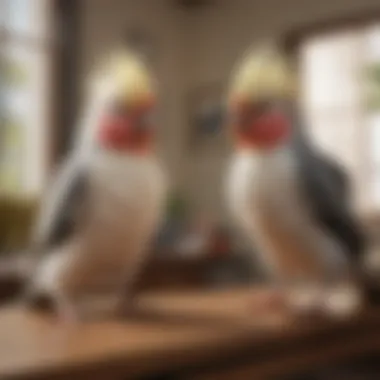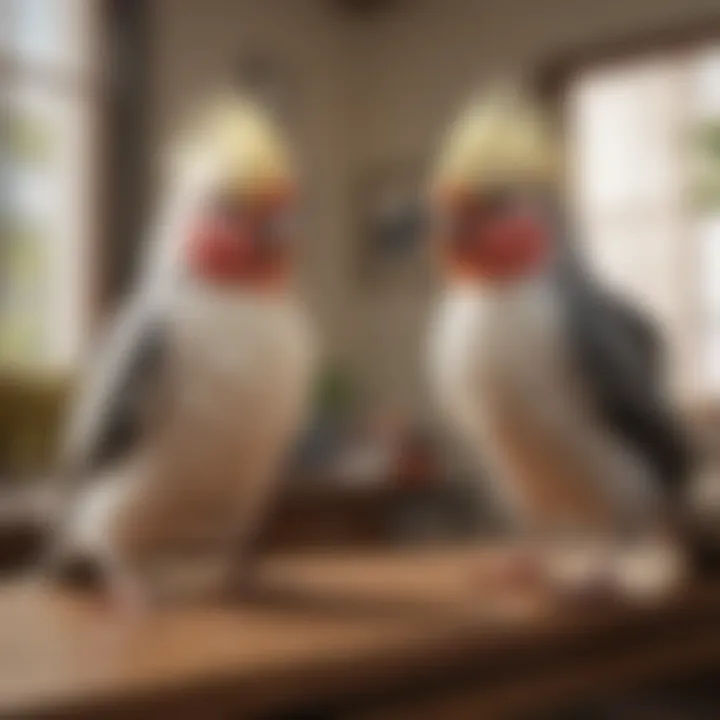Choosing the Right Pet Bird: A Comprehensive Guide


Intro
Choosing a pet bird is an intricate journey that involves more than just picking a colorful feathered friend. It's about understanding the unique traits and needs of each bird species, aligning those with your lifestyle, and ensuring a happy coexistence. With the right knowledge, potential bird owners can navigate the maze of options, from the chirpy budgerigar to the majestic macaw.
As you sift through various avian companions, it’s essential to consider factors that go beyond mere aesthetics. The personality traits, dietary requirements, and environmental needs of birds can vary drastically, making it crucial to dive deep into what different species offer. Whether you are a first-time bird keeper or looking to expand your feathered family, this exploration will arm you with knowledge to foster that harmonious bond that every pet owner desires.
Whether you land on a high-energy parrot or a calm canary, the aim is to ensure you’re picking a bird that complements your lifestyle and enriches both your life and theirs. The next sections will shine light on the pivotal components of bird ownership, from care tips to behavioral insights, nutrition guidelines, wellness considerations, and enriching activities that can keep your feathered friend entertained.
Foreword to Pet Birds
The journey into the world of pet birds is more than just a whimsical thought that dances across a free afternoon. It’s a deep dive into understanding unique creatures that can add color and warmth to our homes. Birds, with their vibrant plumage and enchanting songs, captivate millions. Their companionship enriches lives, fostering an understanding of beauty and nature that is sometimes hard to find in our daily grind. Choosing a pet bird is not simply about selecting a pretty face; it’s about engaging with a living being that possesses its own quirks, personalities, and needs.
This section lays the groundwork for anyone considering welcoming a feathered friend into their abode. From understanding what prompts people to seek avian companionship to taking the first look at popular species, we set the stage for making informed choices. After all, the right winged companion can be a source of joy and comfort, while the wrong choice may lead to challenges that could leave both the owner and bird feeling unloved and misunderstood.
The Appeal of Avian Companionship
We often think about the companionship that comes with cats and dogs, but birds offer an entirely different experience. The appeal of having pet birds lies in their lively nature and sociability, which can brighten up any space. Many find comfort in their songs and chatter, which can fill a quiet room with life. As social creatures, many birds, like parakeets and cockatiels, thrive on interaction with their human caretakers.
They're like little avian therapists, often bringing a calming presence into households. Bird owners frequently share stories of their pets' antics, from mimicking sounds to engaging in playful behavior that keeps their minds sharp.
A pet bird can transform your space into a lively sanctuary filled with songs and chirps that create an atmosphere of cheer.
It's essential to consider, however, that while birds can be charming and delightful, they also require a good deal of care and attention. This balance between companionship and responsibility is pivotal in this exploration.
A Brief Overview of Popular Species
Diving into the realms of pet birds reveals a fascinating array of species, each with its own behaviors, needs, and personalities. Here's a snapshot of a few that are often favored by enthusiasts:
- Parakeets: Known for their playful nature and ability to learn tricks, these small birds are a great choice for beginners.
- Cockatiels: Often regarded as affectionate companions, they can be quite sociable and develop strong bonds with their owners.
- Canaries: Favored for their beautiful songs, canaries are generally low maintenance, suitable for those who prefer a more serene environment.
- Lovebirds: These tiny bundles of energy are known for their social nature and might thrive best when paired.
- Conures: Energetic and playful, conures can be a bit more demanding due to their higher social and activity needs.
Each species presents distinct advantages and challenges. It's worth spending time considering which aligns with your lifestyle and the environment you can offer. As we venture deeper into the intricacies of owning a bird, understanding these unique traits proves crucial in fostering a healthy and vibrant companionship.
Assessing Your Environment
Selecting a pet bird is not merely about the bird's charm or the color of its feathers; it’s about creating a suitable living environment that meets the unique needs of these avian creatures. Understanding how to assess your environment sets the stage for a harmonious relationship between you and your chosen bird. This initial evaluation plays a pivotal role in ensuring the well-being of the bird and can prevent future challenges that might arise from an unsuitable habitat.
Space Requirements for Different Species
Birds, much like people, have their quirks and preferences when it comes to space. Not all bird species are created equal in terms of space requirements. For example, a parakeet may thrive in a smaller cage with ample opportunities to climb and explore, while a macaw needs a spacious enclosure and plenty of room to stretch its wings. When pondering over potential pet birds, consider these key points:
- Room to Move: Smaller birds like finches or canaries may need a cage that’s at least 18 inches wide, while larger species like cockatoos require a cage that’s at least 36 inches wide, giving them ample room to flutter their wings and climb.
- Height Matters: Many birds love to perch high. Opt for a tall cage for species that enjoy climbing, such as budgerigars, so they can exercise naturally.
- Multiple Birds: If you're considering housing more than one bird, remember that each additional bird may require extra space to prevent stress and territorial disputes.
Accommodating Flight Space
Birds are not just caged creatures; they crave the freedom to soar. When setting up your home for your feathered friend, providing proper flight space is crucial. Depending on the species, they may require different setups:
- Indoor Flight Areas: If you have room, designate a safe, bird-proofed area where your pet can fly freely. Remove hazards like ceiling fans, windows, or anything else that might pose a danger.
- Toys and Perches: Add toys and perches throughout this space to keep them engaged and help develop their physical and mental skills. Birds are also known for their inquisitive nature, providing them with a stimulating environment can keep them happy.
- Time Outside the Cage: Remember to schedule daily flight time outside the cage. This not only helps them exercise but also fosters the bond between you and your bird.
Considerations for Multiple Birds
If you’re contemplating welcoming more than one bird into your life, it’s essential to consider how they will interact in shared spaces. Social dynamics among birds can be complex, and ensuring a peaceful coexistence is vital:
- Separate Spaces: When introducing new birds, provide them with separate cages at first. This lets them get used to each other’s presence without feeling threatened.
- Territory Awareness: Each bird may establish its territory. Be aware of this and prepare for some squabbles if they didn’t get properly introduced.
- Feeding Arrangements: Ensure feeding and drinking options are ample. Configuring more than one feeding station can help reduce competition and control any aggressive behavior.
Understanding Bird Behavior
When it comes to selecting the right avian companion, understanding bird behavior is not just a helpful piece of information but a cornerstone of a successful relationship between you and your feathered friend. Birds, much like humans, have their quirks and social needs, which contribute significantly to their happiness and overall well-being. Neglecting these behavioral traits can lead to a host of issues, from stress to physical ailments. A comprehensive grasp of how birds interact with their environment, fellow birds, and humans is instrumental for any potential pet owner.
Social Needs of Pet Birds
Birds are inherently social creatures. In the wild, they thrive in flocks, engaging in complex social interactions that fulfill their emotional and psychological needs. When considering a pet bird, it is important to acknowledge that many species humanize their interactions. From sharing space and engaging in vocal conversations to requiring mental stimulation, these social dynamics can deeply affect their satisfaction.
For instance, a solitary budgerigar can grow lonesome and exhibit signs of distress, such as excessive vocalization or feather plucking. Conversely, when housed in pairs or small groups, many birds display enhanced well-being. However, it is crucial to choose compatible species and consider how their social dynamics might play out in your living environment.


Common Behavioral Traits Across Species
Understanding behavioral characteristics can also shed light on which species might be right for you. Cockatiels, for instance, are known for their playful yet affectionate demeanor, often whistling tunes and mimicking sounds. They thrive on interaction and will bond with their owners quite readily. Meanwhile, canaries typically tend toward independence; they excel in being low-maintenance yet still contribute cheer through their beautiful singing.
- Here are some common traits to consider:
- Sociability: Cockatiels, Conures, and Lovebirds are often more social.
- Vocalization: Canaries excel in song, while Parakeets are known for chatter.
- Curiosity: Conures and Budgies love to explore, requiring safe environments for their adventures.
This array of behaviors can help prospective bird owners determine how their lifestyles align with each species’ characteristics.
Indicators of Stress and Contentment
Being able to identify when your bird is stressed or content can make a world of difference. Stress signals may include aggressive pecking, constant vocalization without breaks, and excessive preening that leads to bald patches. On the flip side, signs of contentment often manifest through relaxed body language, chirping, and social engagement.
Here are some indicators to keep an eye out for:
- Stress Indicators:
- Contentment Indicators:
- Constant squawking or screaming
- Feather plucking
- Aggressive behavior towards people or other birds
- Calm and relaxed posture
- Engaging in play or exploration
- Vocalizations in a varied, melodious form
Understanding these signals enhances both the bird’s and the owner’s quality of life, paving the way for a meaningful bond that flourishes.
By honing in on the behavioral intricacies of pet birds, one can craft an environment that caters not just to the bird’s physical needs but also nurtures its psychological well-being. This approach fosters a satisfying and enriching relationship that makes bird ownership both gratifying and rewarding.
Nutritional Requirements
Understanding the nutritional needs of pet birds is crucial in nurturing their health and well-being. Just like humans, birds require a balanced diet to thrive. The right mix of nutrients supports their bodily functions, boosts their immune systems, and enhances their overall quality of life. When bird owners comprehend how to nourish their avian companions properly, they pave the way for a happy and vibrant pet.
Fundamentals of a Balanced Diet
A balanced diet for pet birds typically includes a combination of seeds, pellets, fresh fruits, and vegetables. Moreover, it’s essential to know what comprises a diet that meets all the needs of a bird. Here are some fundamentals:
- Seeds: While birds love their seeds, making them the sole component of their diet can lead to obesity and other health issues. Seeds often lack critical vitamins and minerals necessary for good health.
- Pellets: Pellets can be an excellent choice because they are formulated to provide a full spectrum of nutrients. Look for products that are made specifically for the species and age of your bird.
- Fresh Fruits and Vegetables: These should make up a substantial part of their diet. Vitamin A-rich veggies like carrots and leafy greens, along with fruits like apples and berries, can provide necessary antioxidants and hydration.
Proper portioning and variety are key. A bird’s diet should reflect what it would naturally consume in the wild, offering an array of textures and flavors.
Species-Specific Dietary Needs
Every bird species has unique dietary requirements. Knowing these specific needs can make a world of difference. For instance:
- Parakeets: They require a mix of seeds and pellets, but they particularly thrive on greens and fresh fruits like apples, bananas, and spinach.
- Cockatiels: These birds enjoy a similar diet; however, they may need added calcium found in cuttlebones or calcium blocks, especially during breeding.
- Canaries: Primarily seed eaters, they should receive small seeds but also need greens and soft foods during breeding season to promote healthy reproduction.
- Lovebirds: They love variety—provide them with grains, seeds, pellets, and fruits to keep them healthy and stimulated.
- Conures: Known for their playful nature, these birds do well on a mix of pellets, seeds, and a variety of fresh produce.
Recognizing Signs of Nutritional Deficiency
Keeping a watchful eye on your bird can help spot any potential nutritional deficiencies. Here are common signs to be aware of:
- Feather Issues: Dull, brittle feathers or excessive molting can indicate insufficient nutrients like protein or fatty acids.
- Behavior Changes: If your bird seems more lethargic or irritable than usual, it might signify a lack of essential vitamins or minerals.
- Digestive Problems: Soft stools or changes in droppings can also point to dietary inadequacies, which may require dietary adjustments.
If any of these signs arise, considering a vet visit may be wise, as they can offer guidance tailored to your bird’s specific needs.
"Nourishing our feathered friends goes beyond just providing food; it requires an understanding of their unique needs, reflective of their species and lifestyle."
Evaluating Different Bird Species
Choosing the right bird is not just about love at first sight. It’s akin to finding a partner who vibes with your lifestyle. Every species comes with its quirks, needs, and varying levels of companionship. Understanding the distinct characteristics of different bird species can make the difference between a harmonious home and a chaotic living situation. This section dives deeper into some of the most beloved pet birds, addressing specific attributes that may suit your family dynamic and living situation.
Parakeets: A Comprehensive Overview
Parakeets, also known as budgerigars, are small yet vibrant birds that hold a special place in the hearts of many pet owners. Their cheerful whistles and sociable nature are hard to resist. Here are some key attributes:
- Affordability: Generally inexpensive, making them accessible for many households.
- Social Butterflies: Parakeets thrive on interaction. They can learn to mimic words and phrases, providing endless entertainment.
- Space Needs: While they prefer flight space, their small size means they can adapt to various living environments, as long as they’re given time out of their cage.
However, potential owners should note their playful and sometimes demanding nature. If you don’t have time for daily interactions, another species might fit better.


Cockatiels: Intelligent and Affectionate
Cockatiels are known for their charming personalities and distinctive crests atop their heads. They are moderately sized and often develop deep bonds with their owners. Consider these factors:
- Unique Whistles: They have a knack for whistling catchy tunes and sounds, which can be a delightful addition to a household.
- Affectionate Companions: Cockatiels often seek affection and enjoy being held or perched on their owner’s shoulder.
- Moderate Size: Their size is ideal for both spacious homes and smaller apartments. Their activity needs are manageable with interactive toys and regular flying time.
Keep in mind, they are sensitive birds. Introduce new experiences gradually, as sudden changes can stress them.
Canaries: Aesthetic and Low-Maintenance
Canaries are well-regarded for their stunning appearance and melodious singing. They bring color and light to any room with less fuss attached:
- Visual Appeal: Available in a rainbow of colors, they can enhance your living space aesthetically.
- Minimal Care: Compared to other birds, canaries are relatively easy to care for. They require less social interaction, making them perfect for those with busy schedules.
- Singing Talent: Their singing is quite lovely, but you must recognize that not all canaries sing all the time; some can be quieter than others.
Nonetheless, canaries are generally solitary creatures. If you’re looking for a bird to interact with you daily, this might not be the best match.
Lovebirds: Social and Lively Companions
Lovebirds are often categorized under smaller parrots and are known for their affectionate and vibrant personalities. They are a joy for social enthusiasts:
- Playful Nature: They are full of energy, making them ideal birds for active individuals.
- Bonding: Lovebirds thrive on companionship, be it human or their species. Consider getting a pair if you want them to socialize.
- Intelligent: With the right training, these birds can learn tricks and simple commands.
On the other hand, their lively disposition may require plenty of stimulation to prevent boredom, which can lead to mischief.
Conures: Playful Personalities
Conures are often considered the clowns of the bird world. They are known for their playful antics and cheerful disposition:
- Vocality: They tend to be quite vocal, ensuring you’re always entertained with their chatter.
- Affectionate: Conures enjoy spending time with their owners and can be quite cuddly, fostering a close bond.
- High Activity Level: They need space to play and explore. A good mix of toys and mental engagement is crucial for their well-being.
Remember, their boisterous nature might not suit every household, especially if you live in a close community where noise levels might be an issue.
It's prudent to evaluate your personal lifestyle, space, and readiness to engage before bringing a bird into your life. Each pet bird species has its unique needs and personalities, and understanding these can lead to a joyful coexistence.
In summary, every bird has its own flavor to contribute to your home, whether you're looking for companionship, beauty, or the sound of chirping. The right choice depends on aligning those bird traits with your lifestyle needs.
Long-Term Commitment Considerations
Choosing a pet bird isn't a fleeting decision; it's more of a long-term commitment that reshapes your life in various ways. It's crucial to think about the long-term impact on your lifestyle, relationships, and finances. Unlike cats or dogs, birds can have remarkably long lifespans. It’s not just about enjoying their company for a few years; you may be sharing your home with your feathered friend for decades. This section dives into several key aspects that every aspiring bird keeper should weigh carefully.
Lifespan of Popular Pet Birds
Birds come with a versatility in lifespans that can put even the most well-planned timelines to the test. For instance, a budgie may span around 5 to 10 years, whereas larger varieties like African Grey Parrots can live 40 years or even longer. This wide variability makes thorough research essential. Knowing how long your potential pet might be around allows you to assess how it fits into your life across different stages.
- Budgies: Average lifespan of 5-10 years.
- Cockatiels: Average lifespan of 10-15 years.
- Conures: Lifespan can be around 10-30 years, depending on species.
- African Greys: Average lifespan often exceeds 40 years.
Physical changes and personality shifts as they age require you to adapt your care methods. Therefore, contemplating the long haul isn’t just wise; it's vital.
Regular Veterinary Care and Health Monitoring
Birds may seem low-maintenance, but they come with unique commitments regarding health care. Regular check-ups are not optional; they're a must. Just like humans, birds can experience health issues that remain hidden until they become severe. Regular vet visits help in early detection and can save not just money, but also heartache down the road.
- Schedule annual check-ups with a vet specializing in avians.
- Watch for signs of common ailments like feather plucking or vocalizations that are unusual.
- Keep detailed notes about eating habits and behaviors; they can signal health problems.
Monitoring a bird's health isn't just about vet visits; it's also about fostering an environment that minimizes stress and health issues. Create a predictable routine that allows them to feel secure and happy.
Understanding the Costs Involved
Let’s face it: keeping a pet isn't just about love and companionship; it’s about money too. Before bringing a bird home, consider the varied costs involved, which often layer up over the years. From initial setup costs to ongoing expenses for food, toys, and medical care, budgeting is a non-negotiable part of preparation.
- Initial Setup: Cage, bedding, toys, and food can quickly add up to anywhere between $200 to $1000 or more.
- Routine Costs: Monthly expenses might include high-quality food, fresh produce, new toys, and replacement items, which could range from $50 to $100.
- Health Care: Annual vet visits plus potential emergencies can easily amount to over $200 a year, or much more depending on the bird's health and age.
Creating a Suitable Habitat


Creating a suitable habitat for pet birds is paramount in establishing a healthy and nurturing environment. A well-thought-out setup not only keeps your feathered friend comfortable but also significantly influences their overall well-being. Considerations like adequate space, safety, and environmental enrichment play vital roles in ensuring your bird thrives in your care.
Cage Requirements for Different Species
Different bird species have unique needs when it comes to cage requirements. For instance, larger birds like African Grey Parrots require spacious enclosures to accommodate their wingspan and encourage exercise. An appropriate cage should ideally be at least two times the bird’s wingspan in height and width. Conversely, smaller birds such as finches find joy in more compact cages with horizontal bars for climbing.
Specific cage features can enhance your bird's quality of life:
- Bar Spacing: The distance between bars is also crucial. For small birds like budgerigars, a bar spacing of 1/2 inch is generally safe, while for larger birds, a spacing of 3/4 inch or more will prevent their heads from getting stuck.
- Materials: Opt for non-toxic materials. Stainless steel cages are preferable as they resist chewing and are easier to clean, while painted metal or plastic cages may pose risks if the finish deteriorates.
- Flooring and Accessories: Avoid wire flooring, as it can harm delicate bird feet. Consider adding a variety of perches, toys, and a secure area for food and water to create a more stimulating environment.
Environmental Enrichment Techniques
Birds, being intelligent creatures, need stimulation to keep boredom at bay, which can lead to behavioral issues. Engaging them through environmental enrichment techniques fosters mental health and promotes natural behaviors:
- Toys: Provide a mix of toys—hanging, shreddable, and interactive—that can intrigue your bird. Rotate toys regularly to maintain novelty.
- Foraging Activities: Encourage natural foraging behavior by hiding food items in different places within the cage or offering specially designed foraging toys. This mimics the search for food in the wild.
- Interaction: Daily interaction, whether through talking or playtime outside the cage, greatly impacts their social needs. Even physical touch can help them feel more secure and bonded with their human companions.
"Birds dissipate stress, but their habitat must be as dynamic as their behavior."
Establishing a Safe Space for Exploration
Creating a safe space for your bird to explore outside of the cage can be enriching and fosters their natural curiosity. It’s essential to bird-proof the area to prevent accidents:
- Remove Hazards: Ensure windows and open doors are securely closed off or covered. Hang curtains or screens to limit their potential for escape. Remove any dangling wires or small objects that may be ingested.
- Designated Play Areas: Set up a play gym or designated area filled with perches and toys where your bird can enjoy safe exploration. Different textures and heights can pique their interest.
- Supervision: Always supervise your bird when they are out of the cage. This allows you to watch for signs of stress or anxiety while they adjust to their surroundings.
Creating a suitable habitat tailored to your bird's specific needs and behaviors is an ongoing process, which can lead to a fulfilling life for both you and your avian companion.
Integrating Your New Bird into Your Home
Bringing a new bird into your home is not just about picking out a cage or selecting the right food. It’s almost like welcoming a new family member. The way in which you introduce your feathered friend to the household can greatly influence their future behavior, health, and overall happiness. A smooth integration can help your new pet feel secure and more relaxed, fostering a bond that thrives in a nurturing environment.
Strategies for a Smooth Transition
- Create a Safe Space: Before your bird arrives, set up a designated area in your home where it can feel safe and comfortable. This could include a cozy cage, some familiar toys, and a quiet atmosphere. Remember, the first few days can be a bit overwhelming for the bird.
- Gradual Acclimatisation: Once your bird is home, don’t rush the interaction. Allow your new pet to explore its surroundings at its own pace. Initially, it might want to stay quietly in its cage. Offer treats and talk gently to it, creating a calming ambiance.
- Routine Establishment: Birds are creatures of habit. Establishing a daily routine for feeding, playtime, and interaction can help reduce anxiety. Knowing what to expect will make your bird feel more secure.
- Minimize Noise and Stressors: If you have a busy household, try limiting loud noises or sudden movements while your bird settles in. Covering the cage lightly with a cloth can help reduce visual stimuli that may be alarming for a new bird.
"Patience is key. Your new bird needs time to adjust, just like you would in a new neighborhood."
- Monitor for Signs of Stress: Keep a close eye on your bird’s behavior during the transition. Indicators, such as excessive feather fluffing or hiding, may signal that your bird is stressed and needs more time to acclimate.
Introducing Pets and Family Members
The introduction of your bird to other pets and family members requires thoughtful consideration. Here are some key points:
- Family Members: It’s essential that all household members understand how to interact with the bird. Teach them to approach calmly and avoid sudden movements; children, especially, need to be reminded to be gentle.
- Other Pets: If you have cats or dogs, introducing them to your new bird should be done with caution. Always supervise their interactions and consider using a barrier, like a cage, until you’re confident the animals can coexist peacefully.
- Gradual Meetings: Start by allowing family members to observe the bird from a distance. Gradually allow closer interactions, ensuring the bird feels secure. This gradual approach will help foster trust.
- Consistent Training: Involving your family in training sessions with the bird can also facilitate a stronger bond. Tasks could include teaching new tricks or simply giving treats for positive behaviors.
By carefully considering your new bird's integration into your home, you lay the foundation for a strong, long-lasting relationship. This may very well be the linchpin for a happy coexistence between your feathered friend and household members alike.
Epilogue: Finding the Right Avian Companion
Choosing the right pet bird is not a decision to take lightly; it’s akin to deciding who will share your space, moments, and even your heart. The conclusion of this article highlights the multifaceted considerations someone must navigate when making such an important choice. Reflecting on what makes a particular species compatible with your lifestyle can lead to a fulfilling experience for both the bird and its human companions.
Understanding compatibility goes beyond surface-level characteristics. Individuals must delve into the unique traits of each bird species, their behavioral patterns, and their social needs. Opting for a species that aligns with your personality and lifestyle not only fosters a harmonious living environment but also enhances the bird's quality of life. Without this reflective process, both parties might find themselves grappling with stress, frustration, and unmet expectations.
“Taking time to consider compatibility paves the way for a long-lasting bond and a happy home.”
Moreover, taking the time to thoroughly research potential bird companions is indispensable. The significance of preparation cannot be overstated. It is imperative to look beyond mere appearances and chirpy personalities and pay close attention to various factors—dietary requirements, living space, and health needs. Armed with a wealth of knowledge, future bird owners will not only help their feathered friends thrive but also cultivate a more rewarding and engaging relationship.
Reflecting on Compatibility
When pondering which bird to bring into your life, the first step involves a genuine reflection on compatibility. Your daily routine, lifestyle, and individual temperament play a significant role in ensuring that both you and your avian companion can exist harmoniously. For instance, while a Parakeet may require socialization and interaction, a Canary might prefer a quieter setting with less frequent handling.
- Consider Social Needs: Think about how much time you can dedicate to your bird. Some species, like Lovebirds, thrive on social interaction and companionship, while others like the Cockatiel might be more independent.
- Behavioral Expectations: Each type of bird exhibits distinct behaviors. Canaries tend to be less boisterous compared to the playful nature of Conures, which may demand more attention and stimulation.
- Long-Term Vision: Reflect on the lifespan of the birds considered. Some species, like African Grey Parrots, can live several decades, potentially shifting your life goals and commitments.
Recognizing these elements allows for informed choices aligning with both human and bird needs, minimizing the risk of misunderstandings down the line.
The Importance of Research and Preparation
Research is often heralded as the bedrock of effective pet ownership, especially in the case of avian companions. Preparing mentally and materially is crucial to paving a smooth path for integrating a new bird into your home.
- Species Knowledge: Before bringing a bird home, it's essential to understand the specific needs of that species, such as environmental preferences and diet. For example, a Green Cheek Conure requires not only a balanced diet but also ample space for flying and playing.
- Setting Up: A well-designed living space makes all the difference. Invest time in creating an engaging habitat complete with toys, suitable perches, and proper ventilation.
- Cost Awareness: Financial readiness plays a critical role as well. From food and cages to regular veterinary check-ups, knowing your budget ahead of time can prevent any surprises.
Investing in research and preparation not only helps ensure you are ready but also fosters a positive environment that contributes to the overall welfare of your new companion.















